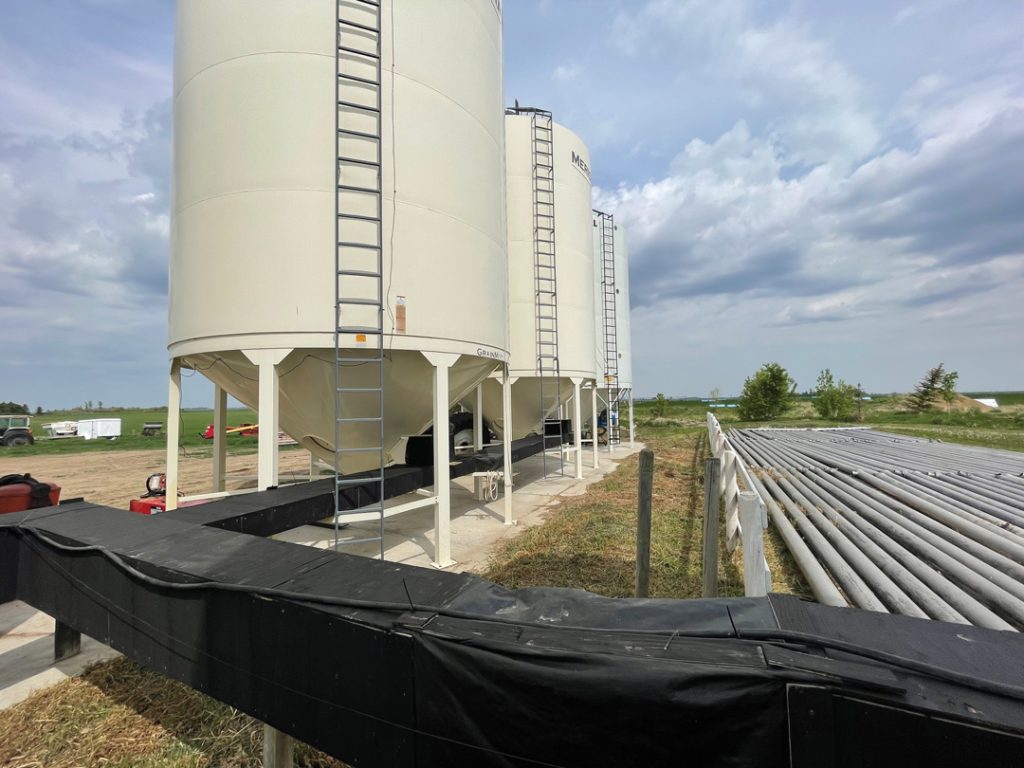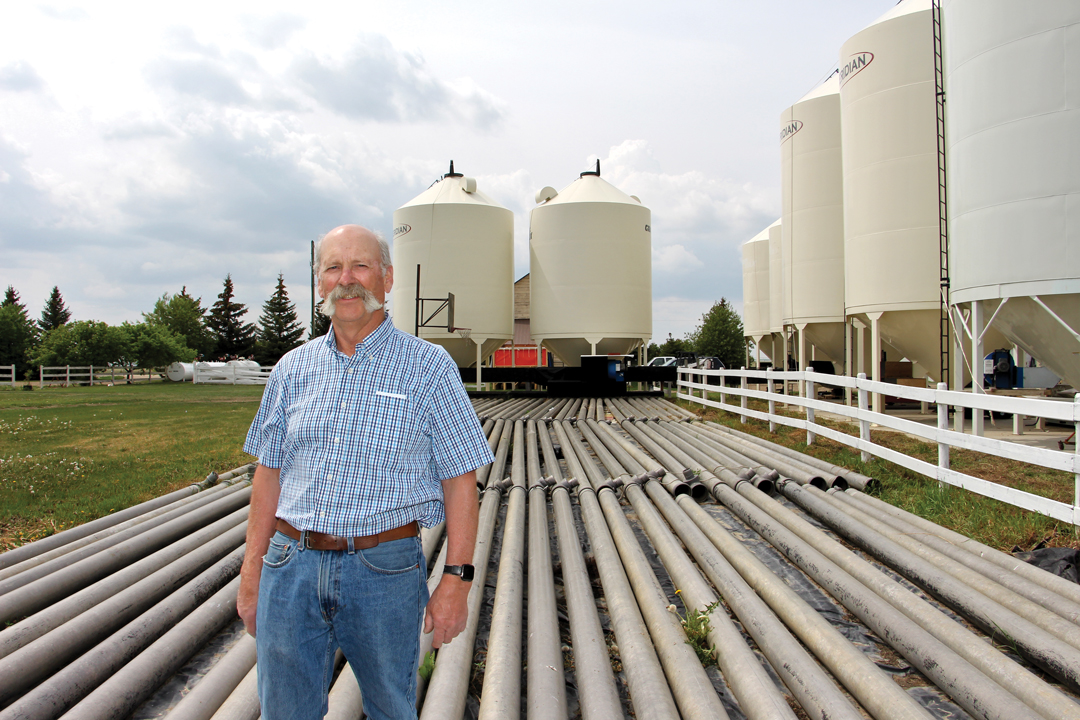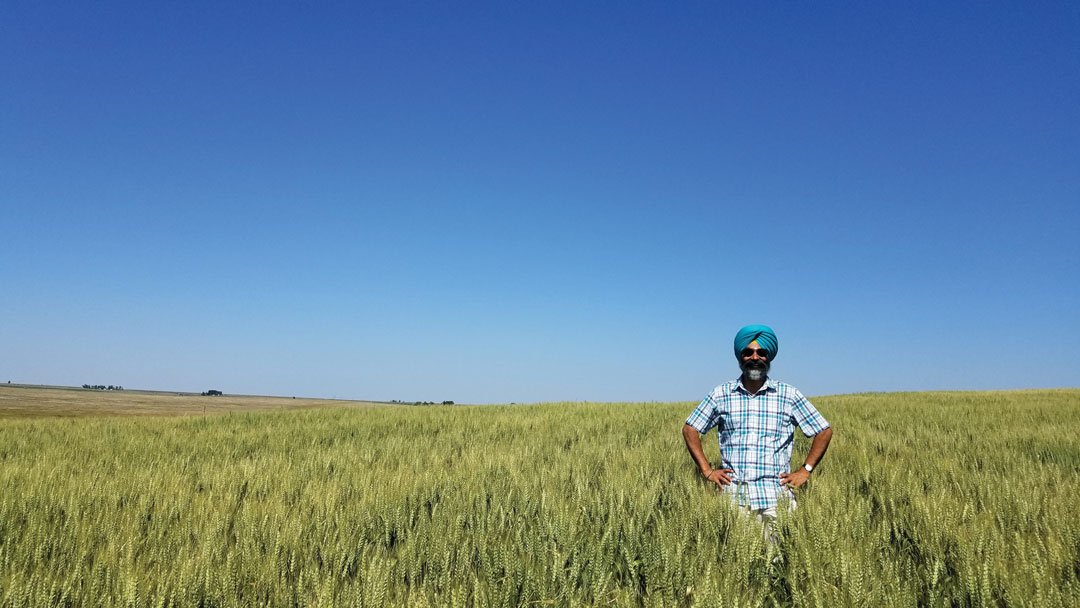CONDITIONING SECRETS SERVED PIPING HOT
BY IAN DOIG • PHOTOS BY ZOLTAN VARADI
On Rob Baerg’s farm near Rosemary, a rectangular array of used aluminum irrigation pipes is nestled within an L-shaped configuration of six hopper bottom grain bins. GrainsWest visited the farm on a day that was not particularly sunny, but the pipes were surprisingly hot. Laid east to west, this is the energy intake of Baerg’s solar grain dryer.
As a 35-year-old carpenter from Surrey, B.C., Baerg purchased a quarter-section near Rosemary in 1988, “for the price of a house in Calgary.” With generous advice and rental equipment from neighbours, he switched careers and became a farmer. His skills in carpentry and concrete served him well as he renovated the property’s rundown farmhouse. He and wife Joyce raised four children and expanded their acres. Baerg now farms wheat, canola and alfalfa with leafcutter bees on two quarter-sections under irrigation.
The dryer site has a power connection Baerg had installed with the intent of building a shop. It now runs a seven horsepower electric fan that draws air through the pipes and into a duct system linked to each bin. A wooden gate at each bin intake can be slid in or out to control airflow.
Analyzed as part of a Team Alberta Crops grain conditioning study released in April 2022, the system was found to consume on average 78 per cent less energy than a comparable in-bin system when drying wheat. Materials to build such a unit, including 60 sections of pipe (he now uses 90), pencil out at just over $19,000.
GrainsWest: What spurred the idea to build a solar powered grain dryer?
Rob Baerg: My neighbour Walter Neufeld and I used to dry grain together. He had a grain dryer, but it was a finicky thing, and we spent a lot of time trying to make that thing work. He eventually took it apart and hauled it out back.
What prompted me to do this in the first place was I lost a bin of durum. On a wet September in 2000, Walter and I were having coffee, trying to think how we could dry grain differently. With aeration, you’re only adding the ambient air. If you can heat that air, you increase its ability to take on moisture. We got the idea irrigation pipes get very hot in the sun, so why not pull air through them? I set up 20 pipes and built a manifold and tried it for two years. It was slow, but it worked.
It was just two cheap farmers who didn’t want to use natural gas, because even that was getting pricey and that was our option. Maybe it’ll be taken off, but the carbon tax later added to it as well.
GW: You were way ahead of your time.
RB: It was before anybody was talking about global warming or carbon footprint. We weren’t doing it for those reasons, and I still don’t. I do it because it’s cheap. Once I built the system, the expense is electricity. Now I’m thinking of getting solar panels on the roof if they can produce enough power to drive my fan. Then the fuel source becomes less expensive.
GW: It could potentially become net zero.
RB: That’s why I thought why aren’t people interested in this approach? Maybe because most farmers want to buy a readymade solution.

GW: It’s an elegantly simple system.
RB: It’s really easy. I don’t have to move a fan to go to the different bins if I’m heating or cooling grain. I just open and close gates. In the aluminum pipes, on a sunny day, the air temperature is raised about 15 degrees before entering the bin and about five to 10 degrees on a cloudy day. I open a door on the intake side to bypass the heating pipes when cold air is desired.
GW: How many times have you rebuilt the system?
RB: The first time it wasn’t big enough, and I was getting more bins. I made sure it worked and then I built a bigger system. But the connections weren’t good, and I had to redo it. I built again and enclosed the plywood ducting in plastic and irrigation canvas and then more plywood. I added metal tubes to compensate for the shifting of the bins. That last renovation was about three years ago.
GW: How do weather conditions affect the efficiency of the system?
RB: We’ve never had a problem. When it’s very cloudy, they don’t heat up much. But with light cloud cover, they’ll still do the job. You wouldn’t get a lot of drying in
November, but we’ve often dried in October. Two bins block the sun later in the day, but I don’t worry about that because it’s what I’ve got.
GW: What sort of regular maintenance does the system require?
RB: Weed control around the perimeter and between the pipes and bins is necessary probably twice a year.
GW: Have you made modifications over the years?
RB: As the system has improved, we now use 90 pipes rather than 20, but 60 is probably enough.
People have asked if I should have painted the pipes black. I tried that once, but it doesn’t stick well to aluminum. I also found the air heats up only so much and then that’s it. So black paint might make you need fewer tubes, but with the number I have out there, it didn’t change anything. The bare aluminum conducts heat quickly. On a sunny day, you can’t walk on those pipes. I use an infrared gun and they get to over 50°C.
GW: Are the results comparable to drying grain with standard systems?
RB: You’re not just drying grain; you protect your crop by getting it in the bin as quick as you can. Now it’s not a risk for me to take off tough grain. Once it’s in the bin, for me, it’s safe, because I know from experience, I can dry it down. I just don’t worry. Sometimes we’ll start and the first two bins are tough and the rest are dry. But it means we can start those two days earlier, then we’ve got work done and grain in the bin.
And since I’ve been doing this, we’ve had very little number 2, let alone number 3. It’s almost always number 1. There’s no sprouting, never a frost issue and it doesn’t sit in the field and get bleached. We get very good colour on it because we’re getting it off sooner.
GW: How much interest has your dryer generated among fellow farmers?
RB: Everybody is really interested when they see it, but I haven’t heard of anyone else building one yet. Maybe it’s too daunting. I’ve been a little puzzled at why no one else seems to be interested in building one like it. But it’s easy to buy a machine that will dry grain.
GW: Have you ever considered marketing your system?
RB: No. One of the most common questions I get is, “Are you thinking of patenting it?” I’m not interested in telling anyone they can’t build it. I would be pleased just to see people do it.
GW: Could someone develop a marketable version of your dryer?
RB: I’ve thought about that. Someone could manufacture a system of pipes on a semi-trailer where the equipment folds out hydraulically. You just open it up when you need it.
It would be nice for it to be commercially available. I’m not going to start a business because I’m too old for that. But it’s just like building anything; once you start, someone else says, “Well, I can build that.” It’s not that hard.







Comments